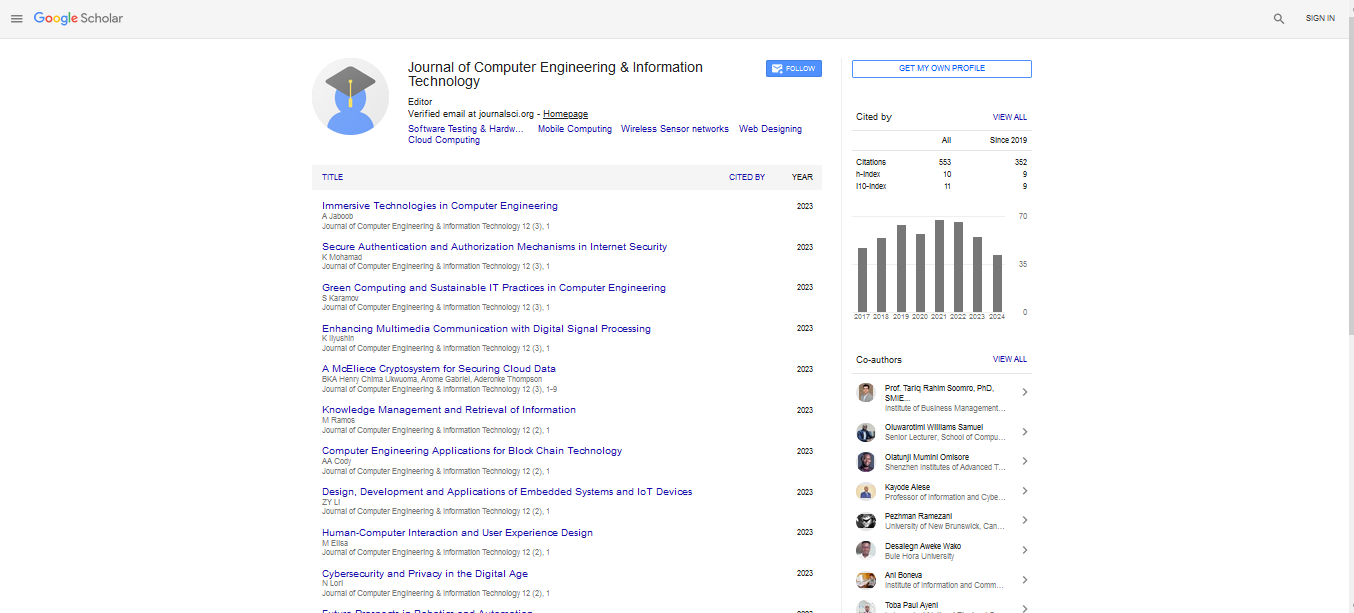Commentary, J Comput Eng Inf Technol Vol: 13 Issue: 6
Mobile Computing in Healthcare: Improving Patient Outcomes through Wearable Devices
Peng Pei*
1Department of Computer Networks, Southeast University, NanJing, China
*Corresponding Author: Peng Pei,
Department of Computer Networks, Southeast
University, NanJing, China
E-mail: peng.pei@seu.edu.cn
Received date: 12 November, 2024, Manuscript No. JCEIT-24-151676;
Editor assigned date: 14 November, 2024, PreQC No. JCEIT-24-151676 (PQ);
Reviewed date: 29 November, 2024, QC No. JCEIT-24-151676;
Revised date: 06 December, 2024, Manuscript No. JCEIT-24-151676 (R);
Published date: 13 December, 2024, DOI: 10.4172/2324-9307.1000323
Citation: Pei P (2024) Mobile Computing in Healthcare: Improving Patient Outcomes through Wearable Devices. J Comput Eng Inf Technol 13:6.
Description
Mobile computing is reshaping healthcare by bringing essential medical services and data to patients in real-time, wherever they are. One of the most transformative aspects of this technology in healthcare is the rise of wearable devices, which track grave health data, provide alerts and offer personalized insights. These devices, when combined with mobile computing, enable continuous monitoring, patient engagement and proactive healthcare interventions that ultimately improve patient outcomes. This paper discuss the role of mobile computing and wearable devices in healthcare, discussing their benefits, challenges and the future potential they hold for patient care.
Mobile computing in healthcare refers to the use of mobile devicessuch as smartphones, tablets and wearables to support medical tasks, data collection and real-time patient monitoring. Healthcare professionals and patients alike can use these devices to access medical records, monitor health indicators and communicate with healthcare providers. Mobile computing allows healthcare systems to become more efficient, reduces hospital visits and empowers patients to manage their health from home. Mobile computing enables continuous health monitoring, allowing for early detection and timely intervention for various medical conditions. Through wearable devices, mobile computing can gather and analyze health data in realtime, giving healthcare providers the ability to track a patient’s status continuously and take action when necessary. Mobile computing encourages patients to take an active role in managing their health. Apps and wearable devices provide data visualizations, reminders and educational content, helping patients better understand their conditions and treatments. This engagement is particularly important for managing chronic diseases, where lifestyle changes and medication adherence play a vital role in outcomes.
The integration of mobile computing with telemedicine enables patients to receive medical consultations without visiting a clinic. For instance, wearable devices can capture vital signs that are then shared with healthcare providers, allowing them to diagnose and manage certain conditions remotely. This not only enhances access to healthcare but also reduces costs for both patients and healthcare systems. Fitness trackers, like Fitbit and Garmin, monitor physical activity, heart rate, calories burned and sleep quality. Although originally designed for fitness enthusiasts, they are now widely used to encourage healthy habits among people of all ages. Many fitness trackers also feature health monitoring functionalities, making them useful for general wellness and preventive care. Smartwatches, such as the Apple Watch, combine fitness tracking with additional features like ECG monitoring, blood oxygen level measurement and fall detection. Smartwatches also integrate with mobile health apps, allowing users to track long-term trends and share data with healthcare providers.
This makes them particularly useful for patients managing chronic conditions like heart disease or diabetes. Continuous Glucose Monitors (CGMs), like the Dexcom G6, are designed specifically for diabetes management. They continuously measure blood glucose levels, alerting patients when their glucose falls outside of safe ranges. These devices are particularly important for diabetes patients, as they enable real-time monitoring without the need for frequent finger-prick tests. The data from CGMs can be shared with healthcare providers or caregivers, enabling better diabetes management. Wearable blood pressure monitors, such as Omron’s Heart Guide, allow patients with hypertension to monitor their blood pressure throughout the day. Traditional blood pressure monitoring requires visiting a clinic or using bulky home devices, but wearables make this process more convenient, allowing patients to monitor and manage their blood pressure more effectively. Wearable ECG monitors are especially useful for patients with heart conditions, as they enable long-term cardiac monitoring outside the hospital. Devices help patients avoid hospitalizations by enabling early detection and management of cardiac events.
 Spanish
Spanish  Chinese
Chinese  Russian
Russian  German
German  French
French  Japanese
Japanese  Portuguese
Portuguese  Hindi
Hindi 